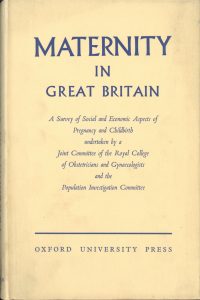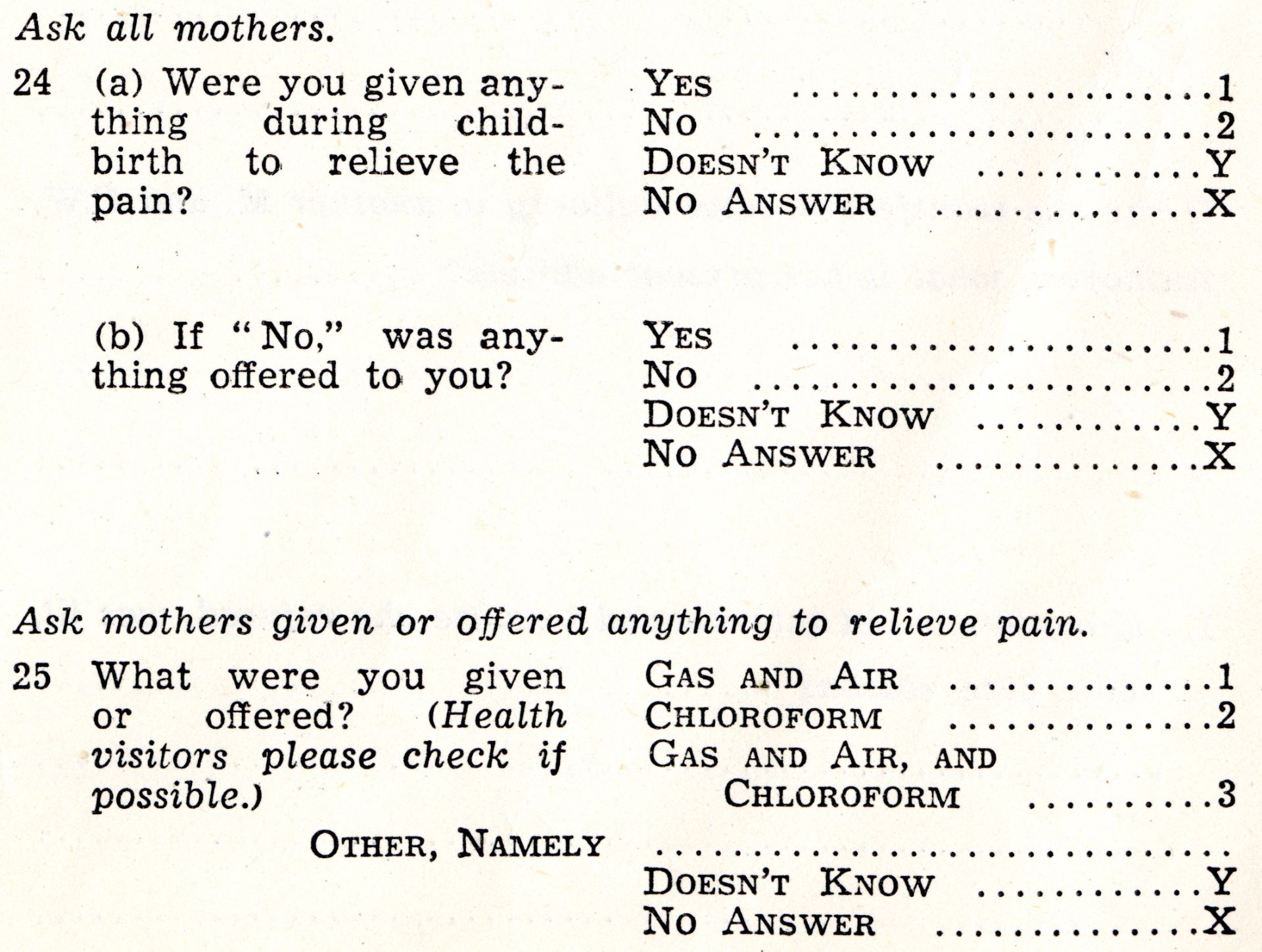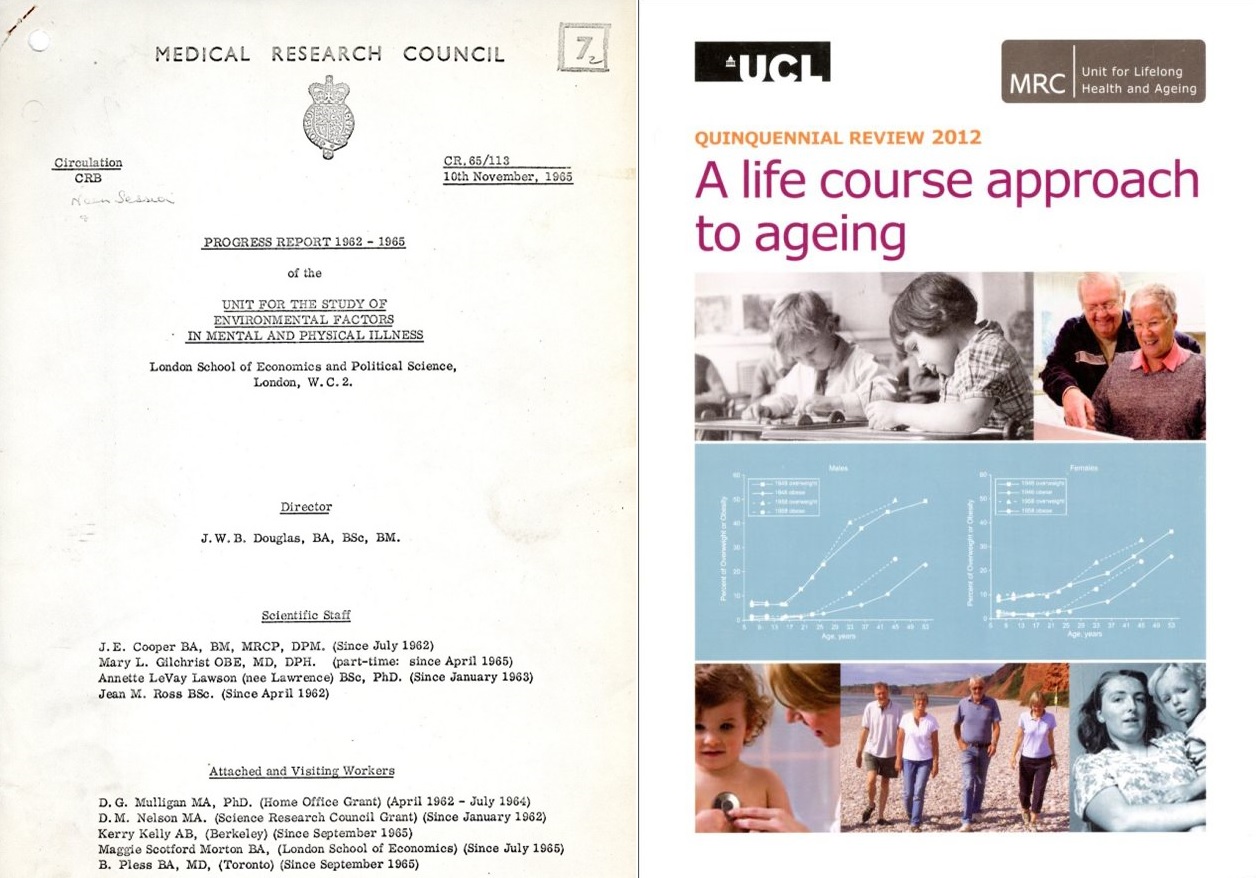Cataloguing the records of Britain’s longest-running birth cohort study
By Kurt M Jameson, on 30 July 2021
For the last year or so I’ve been working on a project to catalogue the administrative records of the National Survey of Health and Development (NSHD) – Britain’s longest running birth cohort study. Although this project has been a little disrupted by the pandemic, I’m very happy to say the cataloguing is now complete!
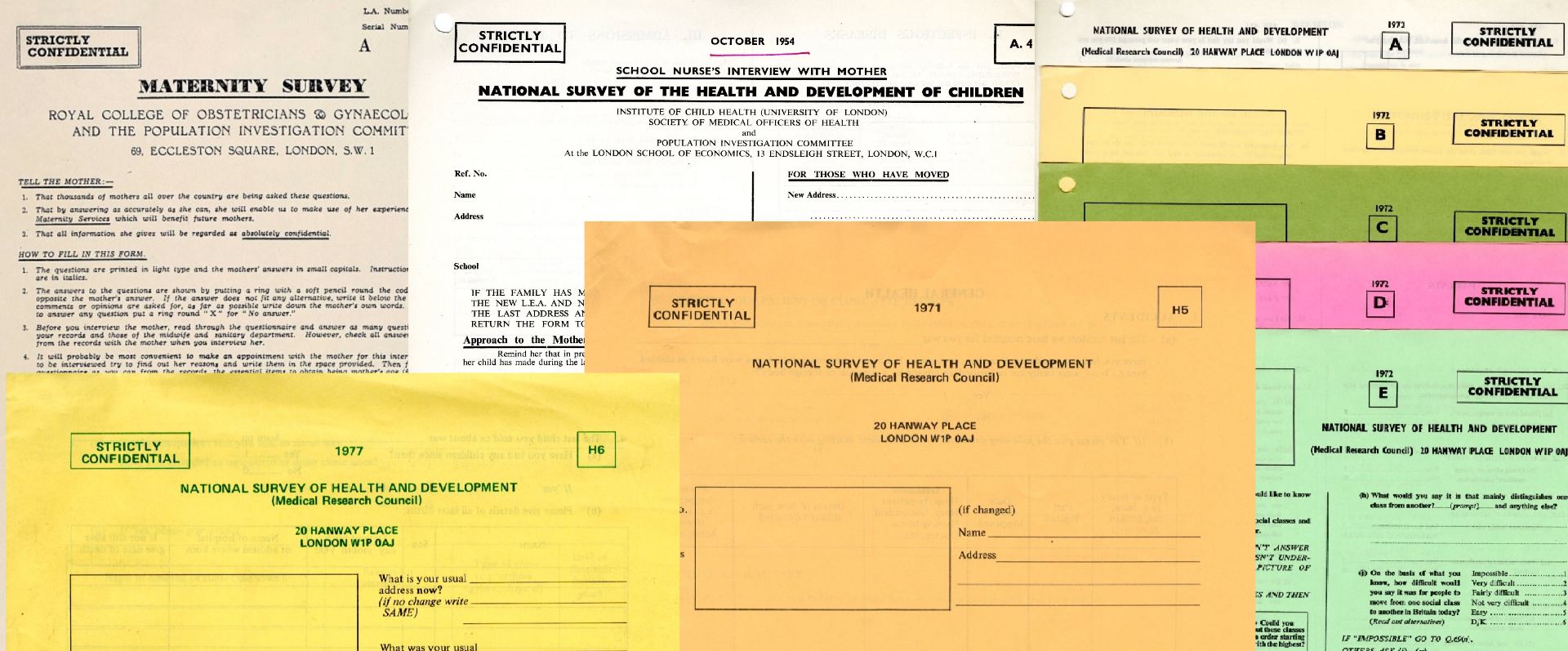
A selection of questionnaires and interview booklets that have been used in the NSHD over the years.
The history and impact of the National Survey of Health and Development (NSHD)
The NSHD is referred to as a ‘cohort study’ or ‘longitudinal study’ because it studies the same group of people over time, collecting data from them at fairly regular intervals (in the NSHD they are referred to as ‘study members’). Monitoring the same group of people throughout their lives means that cohort studies can highlight differences in health and development that arise due to life circumstances and experiences.
The NSHD began in 1946 as a one-off maternity survey. The 1930s and early ‘40s was a period of anxiety in Britain over declining birth rates and high infant death rates. At the time, this also included concerns over the national economy, and whether Britain would have enough people to run the Empire. A national maternity survey was planned, to understand why people were having fewer children. It consisted of interviews with the new mothers of 13,687 babies that had all been born in Britain in the same week in March 1946. It was directed by James Douglas, a young doctor and pacifist who had gained experience of carrying out surveys and data analysis on air-raid casualties during the war. Ironically, by the time the findings of the maternity survey were published in 1948, Britain was experiencing its post-war ‘baby boom’. Although fears over fertility rates had now subsided, the survey still produced some shocking revelations.
The science journalist Helen Pearson summarises the findings of the 1946 maternity survey in her book The Life Project, which gives a history of Britain’s birth cohort studies:
“Almost every result that tumbled out of Douglas’ tabulating machine showed a country divided by class. The babies in the lowest class were 70% more likely to be born dead than those in the most prosperous, and they were also far more likely to be born prematurely.”
These outcomes were largely the result of the costs involved in accessing good antenatal care at the time. The 1946 maternity survey also highlighted that most women were unable to access any pain relief during childbirth. These findings of the maternity survey contributed to the shaping of the early NHS (launched in 1948), and led to a change in the rules so that midwives were able to administer pain relief more freely.
Although the maternity survey was intended as a one-off, about a third of the babies were selected for a follow-up survey, and it became the basis for an ongoing longitudinal study of health and development. In addition to health, the NSHD became influential in education and social policy. Douglas published the book The Home and the School in 1964, which demonstrated that children from more disadvantaged backgrounds were much less likely to go to grammar school, even when they were judged to be of similar ability. These findings contributed to the introduction of the ‘comprehensive’ school system in 1965.
Although the NSHD’s funding was precarious in its early years, from 1962 it secured regular core funding from the Medical Research Council (MRC). In its later years the NSHD evolved into a study of adult health (including mental health), and the life factors involved in developing certain illnesses and conditions. Today the NSHD remains an active, ongoing study, now oriented towards being a study of ageing. It has just had its 75th birthday as the NSHD study members turned 75 in March 2021. This online talk on the history of the NSHD was given as part of the 75th birthday celebrations:
As mentioned in that talk, the NSHD cohort is representative of the racial demographics of Britain when the study began, rather than Britain’s racial demographics today. As the NSHD study members were born in 1946, before the significant levels of immigration to Britain that happened in subsequent decades, the cohort is therefore overwhelmingly white. However, the impact of the NSHD provided the inspiration for several later British cohort studies, notably the 1958 National Child Development Study, the 1970 British Cohort Study, and the Millennium Cohort Study. These three later cohort studies are administered by a different organisation, the Centre for Longitudinal Studies (CLS), whose archives are also stored at UCL.
What’s in the NSHD archive?
It’s important to stress that none of the research data are included in this archive – this in an administrative archive whose documents demonstrate which kinds of data were collected, why particular questions were asked, and how the study has changed over time. A key part of the NSHD archive is the series of blank questionnaires and interview booklets, running from the 1946 maternity survey through to the present. From these you can see each and every question that has been asked as part of the study. The topics they cover include health, education, employment, income, housing, family, and social attitudes. The study members also took cognitive and attainment tests at ages 8, 11, and 15.

A page from the ‘Picture Intelligence Test’ given to the NSHD study members when they were aged 8, as part of the 1954 data collection (NSHD/2/8/3).
In 1962, the NSHD study members turned 16, which meant it would be much harder for the study to keep in touch with them. As a result, the NSHD began sending birthday cards to each study member every March (remember the NSHD study members all have roughly the same birthday!) Each year the card would have a new design, sometimes chosen through competitions. In a recent article, Hannah Elizabeth and Daisy Pailing explain how the NSHD birthday cards have evolved over time, how they led to the development of close bonds between the NSHD and its study members, and how the birthday cards demonstrate “the growing awareness of importance of emotion within British social science research communities”.

The first NSHD birthday card was sent out in March 1962, when the study members turned 16. The 1962 card is the only NSHD birthday card to have designs for different genders: female, left (NSHD/8/2/1/1); and male, right (NSHD/8/2/1/2).
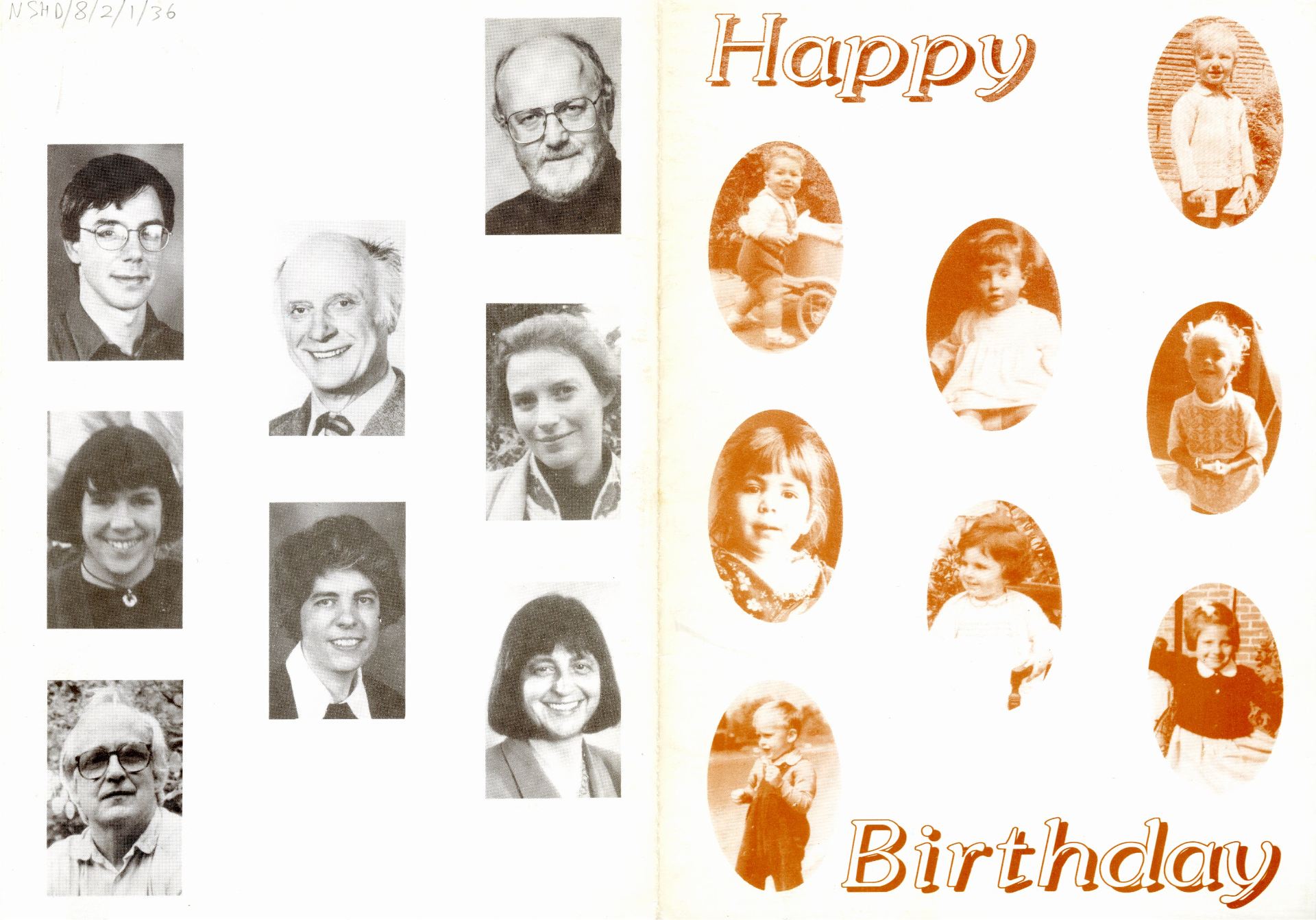
The 50th birthday card, sent out in March 1996, featured pictures of NSHD staff members (NSHD/8/2/1/36). James Douglas (top, centre) was director of the NSHD 1946-1979; Michael Wadsworth (top right) was director 1986-2006; and Diana Kuh (bottom right) was director 2007-2017.
The archive also contains a wealth of planning documents, progress reports and grant applications, which demonstrate the rigorous and constant scrutiny involved in the study, and which also document the way the study has evolved over time. These records will allow researchers to see not just which questions were asked but why those particular questions were asked, and not others. These documents also capture the way that the importance of ethics and consent have changed over time in scientific research.
This cataloguing project was given the title ‘Interconnections’ due to the links between social science and medical science in the NSHD. The NSHD archive will therefore be of particular interest to researchers of either field.
You can now browse the catalogue for the NSHD archive through the UCL online catalogue: https://archives.ucl.ac.uk/CalmView/.
To make an appointment to access the archive in our reading room at the UCL Institute of Education, contact ioe.arch-enquiries@ucl.ac.uk.

This cataloguing project has been funded by the Wellcome Trust.
 Close
Close


